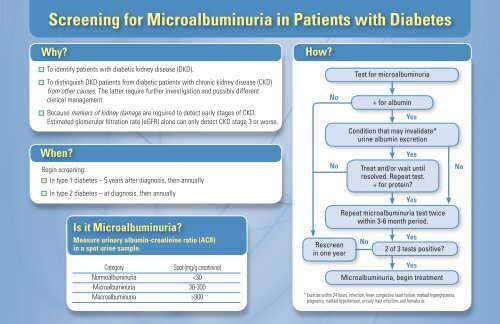Screening for Microalbuminuria in Patients with Diabetes
Screening for Microalbuminuria in Patients with Diabetes
Screening for Microalbuminuria in Patients with Diabetes
Create successful ePaper yourself
Turn your PDF publications into a flip-book with our unique Google optimized e-Paper software.
<strong>Screen<strong>in</strong>g</strong> <strong>for</strong> <strong>Microalbum<strong>in</strong>uria</strong> <strong>in</strong> <strong>Patients</strong> <strong>with</strong> <strong>Diabetes</strong><br />
Why<br />
How<br />
To identify patients <strong>with</strong> diabetic kidney disease (DKD).<br />
To dist<strong>in</strong>guish DKD patients from diabetic patients <strong>with</strong> chronic kidney disease (CKD)<br />
from other causes. The latter require further <strong>in</strong>vestigation and possibly different<br />
cl<strong>in</strong>ical management.<br />
Because markers of kidney damage are required to detect early stages of CKD.<br />
Estimated glomerular filtration rate (eGFR) alone can only detect CKD stage 3 or worse.<br />
When<br />
Beg<strong>in</strong> screen<strong>in</strong>g:<br />
In type 1 diabetes – 5 years after diagnosis, then annually<br />
In type 2 diabetes – at diagnosis, then annually<br />
Is it <strong>Microalbum<strong>in</strong>uria</strong><br />
Measure ur<strong>in</strong>ary album<strong>in</strong>-creat<strong>in</strong><strong>in</strong>e ratio (ACR)<br />
<strong>in</strong> a spot ur<strong>in</strong>e sample.<br />
No<br />
No<br />
Rescreen<br />
<strong>in</strong> one year<br />
Test <strong>for</strong> microalbum<strong>in</strong>uria<br />
+ <strong>for</strong> album<strong>in</strong><br />
Yes<br />
Condition that may <strong>in</strong>validate*<br />
ur<strong>in</strong>e album<strong>in</strong> excretion<br />
Treat and/or wait until<br />
resolved. Repeat test.<br />
+ <strong>for</strong> prote<strong>in</strong><br />
Repeat microalbum<strong>in</strong>uria test twice<br />
<strong>with</strong><strong>in</strong> 3-6 month period.<br />
No<br />
Yes<br />
Yes<br />
Yes<br />
2 of 3 tests positive<br />
Category<br />
Spot (mg/g creat<strong>in</strong><strong>in</strong>e)<br />
Yes<br />
Normoalbum<strong>in</strong>uria 300 * Exercise <strong>with</strong><strong>in</strong> 24 hours, <strong>in</strong>fection, fever, congestive heart failure, marked hyperglycemia,<br />
pregnancy, marked hypertension, ur<strong>in</strong>ary tract <strong>in</strong>fection, and hematuria.<br />
No
<strong>Screen<strong>in</strong>g</strong> <strong>for</strong> <strong>Microalbum<strong>in</strong>uria</strong> <strong>in</strong> <strong>Patients</strong> <strong>with</strong> <strong>Diabetes</strong><br />
Is it DKD<br />
CKD should be attributable to diabetes if:<br />
Macroalbum<strong>in</strong>uria is present; or<br />
<strong>Microalbum<strong>in</strong>uria</strong> is present:<br />
• <strong>in</strong> the presence of diabetic ret<strong>in</strong>opathy<br />
• <strong>in</strong> type 1 diabetes of at least 10 years’ duration<br />
Album<strong>in</strong>uria<br />
GFR (mL/m<strong>in</strong>) CKD Stage* Normoalbum<strong>in</strong>uria <strong>Microalbum<strong>in</strong>uria</strong> Macroalbum<strong>in</strong>uria<br />
>60 1 + 2 At risk † Possible DKD DKD<br />
30-60 3 Unlikely DKD ‡ Possible DKD DKD<br />
















